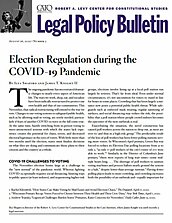The November election looms large as a challenge to the “new normal” of the pandemic world. Whereas fighting COVID-19 optimally requires social distancing, limiting trips to public spaces (at least indoors), and sequestering higher‐risk groups, elections involve lining up at a local poll station run largely by retirees. That’s far from ideal. Even under normal circumstances, it’s not uncommon for voters to stand in line for hours in some places. Crowding that has been largely a nuisance now poses a potential public health threat. While safeguards such as enforced mask wearing, regular sanitizing of surfaces, and social distancing may reduce the risk, the possibility that a poll station where people crowd indoors becomes the epicenter of the next outbreak is real.
Exacerbating the situation, the novel coronavirus has caused poll workers across the nation to drop out, as most are over 60 and thus in a high‐risk group.1 The predictable result of the loss of poll workers has been fewer polling stations serving more voters. In Wisconsin’s April primary, Green Bay was forced to reduce its Election Day polling locations from 31 to only 2, “as only 17 poll workers of the city’s roster of 270 were able to work.”2 Similarly, in the District of Columbia’s June primary, “there were reports of long wait times—some multiple hours long.… The shortage of poll workers to sanitize voting machines and process ballots nearly ground the system to a halt,” despite lower‐than‐average turnout.3 Having fewer polling places leads to more crowding, and crowding increases both the possibility of an outbreak and—equally important for voter access—the fear of one. The riskier a polling place seems, the less willing voters will be to participate. Even for the most civic‐minded and politically engaged citizens, the hazard to one’s own health and that of loved ones may be too high a price for voting. Worse, health‐based disincentives to vote would hardly fall evenly on the population; groups that are at higher risk of serious complications from COVID-19, such as the elderly, the immunocompromised, and communities with poor access to health care, will face stronger disincentives to vote than others, potentially skewing elections and decreasing the perceived legitimacy of their results.



